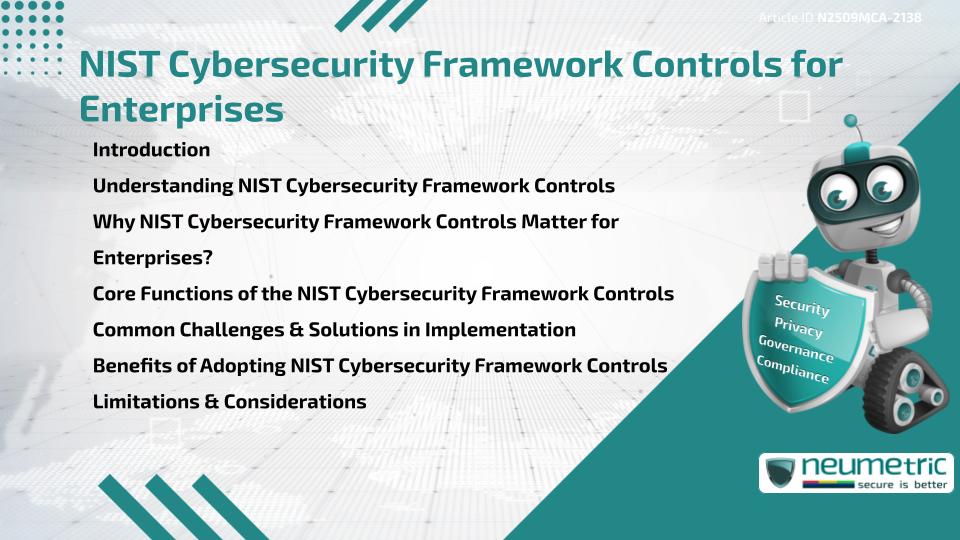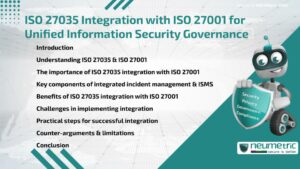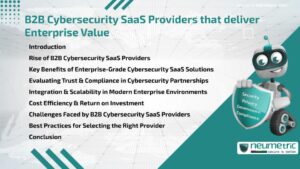Table of Contents
ToggleIntroduction
The NIST CyberSecurity Framework Controls provide Enterprises with Structured practices to manage CyberSecurity Risks & Enhance Resilience. Developed by the National Institute of Standards & Technology [NIST], the Framework offers a flexible, Risk-based approach adaptable to organisations of all sizes. This Article explains the Framework, its Core Functions, Challenges & Benefits for Enterprises.
Understanding NIST CyberSecurity Framework Controls
The NIST CyberSecurity Framework [CSF] was originally designed to improve Critical Infrastructure Security but has since been widely adopted across Industries. The NIST CyberSecurity Framework Controls are not prescriptive, instead, they provide guidelines to help Enterprises identify, protect, detect, respond & recover from CyberSecurity Threats.
For reference, see the NIST CyberSecurity Framework.
Why NIST CyberSecurity Framework Controls Matter for Enterprises?
Enterprises face increasing Threats from Ransomware, Phishing & Supply Chain Attacks. The NIST CyberSecurity Framework Controls matter because they:
- Provide a Common Language for managing CyberSecurity Risks.
- Align with International Standards like ISO 27001.
- Support Compliance with Sector-specific Regulations such as HIPAA & PCI DSS.
- Enhance trust with Regulators, Customers & Business Partners.
The CyberSecurity & Infrastructure Security Agency (CISA) promotes the Framework as a foundation for Enterprise Resilience.
Core Functions of the NIST CyberSecurity Framework Controls
- Identify – Understand Assets, Risks & Vulnerabilities to manage Threats effectively.
- Protect – Implement Safeguards such as Access Controls, Encryption & Training.
- Detect – Use monitoring & analytics to identify Potential Incidents quickly.
- Respond – Establish plans to contain & mitigate the impact of CyberSecurity Events.
- Recover – Restore operations & improve resilience after an Incident.
The ENISA CyberSecurity guidelines also reflect these Principles in European contexts.
Common Challenges & Solutions in Implementation
- Resource Constraints – Smaller Enterprises can adopt the Framework in Stages to spread Costs.
- Complexity – Map existing Controls to the Framework to simplify Integration.
- Lack of Awareness – Conduct Training Programs to improve Staff understanding of Responsibilities.
- Evolving Threats – Use Continuous Monitoring & Regular updates to stay aligned with Risks.
The ISACA implementation resources offer Practical guidance.
Benefits of Adopting NIST CyberSecurity Framework Controls
- Stronger Security Posture – Reduces Vulnerability to Cyber Threats.
- Regulatory Alignment – Supports Compliance with multiple Industry Standards.
- Operational Resilience – Ensures Quicker Detection, Response & Recovery.
- Business Trust – Demonstrates Accountability to Customers & Stakeholders.
Limitations & Considerations
The NIST CyberSecurity Framework Controls are voluntary & may require adaptation for specific industries. Enterprises must customise them based on Risk Appetite, Size & Regulatory requirements. Over-reliance on the Framework without broader Governance may leave Gaps.
Takeaways
- The NIST CyberSecurity Framework Controls provide a structured, flexible approach to managing Cyber Risks.
- They include five Core Functions: identify, protect, detect, respond & recover.
- Adoption strengthens Security, Compliance & Enterprise trust.
FAQ
What are NIST CyberSecurity Framework Controls?
They are guidelines developed by NIST to help organisations manage & reduce CyberSecurity Risks.
Are they mandatory?
No, they are voluntary but widely adopted across Industries.
Can Small Businesses use the Framework?
Yes, the Framework is scalable & adaptable to organisations of any size.
How does it relate to ISO 27001?
It complements ISO 27001 by providing a Practical Risk-based approach.
Why should Enterprises adopt it?
It strengthens CyberSecurity Resilience, Supports Compliance & Builds Stakeholder trust.
References
- NIST – CyberSecurity Framework
- CISA – CyberSecurity Resources
- ENISA – CyberSecurity Guidelines
- ISACA – Implementation Resources
- IT Governance – CyberSecurity Guidance
Need help for Security, Privacy, Governance & VAPT?
Neumetric provides organisations the necessary help to achieve their CyberSecurity, Compliance, Governance, Privacy, Certifications & Pentesting needs.
Organisations & Businesses, specifically those which provide SaaS & AI Solutions in the Fintech, BFSI & other regulated sectors, usually need a CyberSecurity Partner for meeting & maintaining the ongoing Security & Privacy needs & requirements of their Enterprise Clients & Privacy conscious Customers.
SOC 2, ISO 27001, ISO 42001, NIST, HIPAA, HECVAT, EU GDPR are some of the Frameworks that are served by Fusion – a SaaS, multimodular, multitenant, centralised, automated, CyberSecurity & Compliance Management system.
Neumetric also provides Expert Services for technical Security which covers VAPT for Web Applications, APIs, iOS & Android Mobile Apps, Security Testing for AWS & other Cloud Environments & Cloud Infrastructure & other similar scopes.
Reach out to us by Email or filling out the Contact Form…





